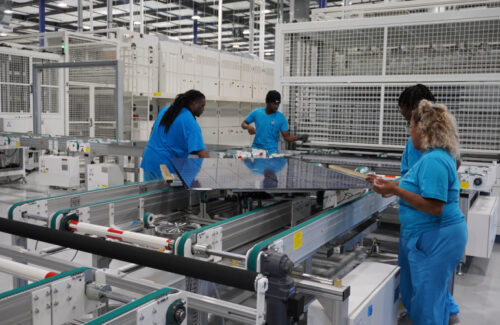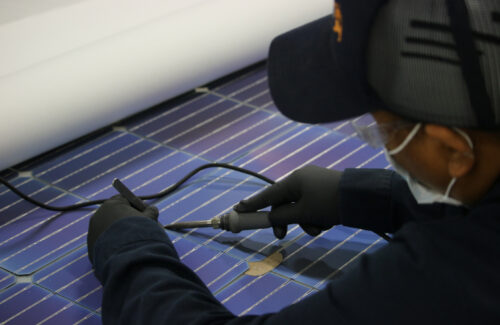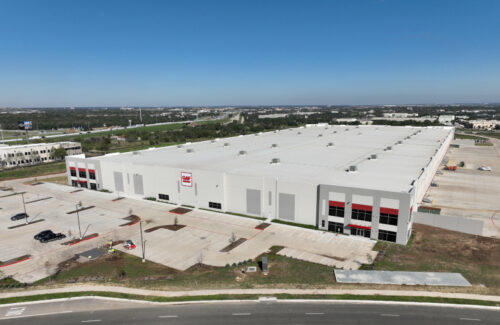 Perhaps capitalizing on the recognized technological prowess of ‘Silicon Valley’, an industrial area in eastern Germany named itself ‘Solar Valley’ in the early 2000s after several solar manufacturers employed thousands of people just off the main road Sonnenallee (‘Sun Avenue’). Twenty years later, Solar Valley in Thalheim, Germany, has lost its appeal, with companies leaving the area as quickly as they established themselves. Now a new Solar Valley is forming in a surprising location: the largest oil and gas hub in the Western Hemisphere.
Perhaps capitalizing on the recognized technological prowess of ‘Silicon Valley’, an industrial area in eastern Germany named itself ‘Solar Valley’ in the early 2000s after several solar manufacturers employed thousands of people just off the main road Sonnenallee (‘Sun Avenue’). Twenty years later, Solar Valley in Thalheim, Germany, has lost its appeal, with companies leaving the area as quickly as they established themselves. Now a new Solar Valley is forming in a surprising location: the largest oil and gas hub in the Western Hemisphere.
Thanks to the Inflation Reduction Act, the United States has recently become an attractive place for solar energy production. But no state has seen more manufacturing activity than oil-rich Texas. Take your pick – Dallas, Houston or somewhere along the way – more inverter, mounting and solar panel manufacturers are heading to the Lone Star State. Lured by favorable tax breaks and plenty of open space for massive factories, solar companies are taking their chances on Texas. But will they succeed?
Why Texas?
A red state with fossil fuel interests isn’t the first place you’d think to find the new solar hotspot, but Texas offers companies several good reasons to set up production bases within its borders, including sales tax exemptions for production equipment and no corporate or personal income tax. The state also specifically offers solar energy producers an exemption from franchise taxes. Add to that a civilian workforce of more than 15 million people that is among the youngest in the country, and Texas appears to be the best place to build solar energy manufacturing operations.
According to World of solar energy According to data, the state has 10 solar panel manufacturers (four active, six announced), three inverter manufacturers (two active, one announced) and six mounting manufacturers (five active, one announced). Houston will soon be the most concentrated area in the United States for solar panel production. At least four companies expect to start assembling panels next year, employing nearly 3,000 people.
Sirius PV is one of those companies. The panel manufacturer, backed by Elin Energy in Turkey, is building a 250,000 ft2 plant in Brookshire with an annual capacity of 2 GW. Sirius ultimately wants three shifts, but finds the onboarding process more difficult than expected.

Production of solar panels at the Sirius PV factory outside Houston. Credit: Sirius PV
“We do our utmost to find the right people, but that is not easy. It was a challenge in Texas, and we didn’t expect this,” said Ercan Kalafat, CEO of Sirius PV. “We can overcome the challenge because we have the tools to do so, but we hoped it would be easier.”
Sirius brought in experienced employees from its Turkish factories to train new employees in Houston. Due to the lengthy training process, the company is currently operating one shift and expects the second shift to be fully trained by the end of the second quarter. Kalafat said the biggest obstacle is the lack of experience in solar energy production in the area. While Texas is well-versed in high-technology manufacturing, even an automated solar panel assembly plant requires specific skills.
“I’m not saying solar energy production didn’t exist, but it was very limited [in the United States]. There is no ecosystem where you have people who know this work,” he said. “Can we adapt to other production processes? Yes. But being a stringer operator or a laminator operator is a very specific job. Once we are fully up and running, this will be a 500 person operation. We need to take care of this now so that we can have as many talented people available in the future.”
Canadian solar energy is building a 5-GW panel assembly plant in Mesquite, a suburb of Dallas. Thomas Koerner, corporate senior VP at Canadian Solar, said the company has found a strong labor pool in the region, but recognizes the benefit of an established global manufacturing footprint. Like Sirius PV, Canadian Solar relies on employees from its existing plants to train the U.S. workforce.
“We are the most internationally producing manufacturer, so we know how to make it work,” Koerner said. ‘We can steer [new workers] to Thailand, train them there for two to eight weeks and then bring them back as trainers [in the United States].”
Canadian Solar expects to employ 1,500 people at its 753,000 ft2 factory and posts new vacancies online every day. The company has shipped its first American-assembled panels, but will only be able to function as the nation’s largest manufacturer of silicon solar panels if it fills every open position.
Social assistance
According to the 2023 Solar Jobs Census, employment in solar energy production reached 33,473 jobs in 2022, representing 13% of total solar industry jobs in the United States. A survey of respondents found that 73% of employers in the industry found it difficult to hire qualified workers – and that was before the IRA boom of announced manufacturers.
Although much attention has been paid recently to developing vocational training for the installation sector, thousands of workers are still needed in production. Community organizations across Texas have supported this effort.
Project QUEST, a nonprofit organization that connects adults with in-demand job training for a living wage, has been serving the San Antonio region since 1992 and its model has been adopted throughout the state and surrounding areas. Francisco Martinez, president and CEO of Project QUEST, said the nonprofit does not provide training but instead acts as a bridge between local citizens and the workforce in need of workers.
“Over the years the definition of which career paths in which areas has changed, but recently there has been a big push for advanced manufacturing and our partnership with clean jobs has grown,” he said.

Credit: Mission Solar Energy
Project QUEST is partnering with OCI Solar Power to increase solar energy education through St. Philip’s College in San Antonio. OCI and its companies, including panel manufacturer Mission Solar Energy, have done so concerned $500,000 over three years to the college to support students completing the solar training program.
“We are optimistic about developing and continuing to grow that field,” Martinez said. “We have been in advanced manufacturing and other fields before, but nothing is as unique as this solar opportunity.”
He said it is often difficult to get individuals to recognize careers in new fields because they were not exposed to those job opportunities growing up.
“We’re trying to make sure that the people who are a good fit for these programs have a way in and access to those career training opportunities,” Martinez said. “Many people may not be aware of solar careers, so in partnership with OCI and St. Philip’s, we are doing our best to educate people about the career field. They are pioneers in the sense that no one in their family has done this before. There is no second-generation tanning professional. We offer these support services to motivate and encourage them to keep going.”
GAF energy, which opened its 250 MW solar manufacturing facility half an hour outside of Austin in late 2023, is training first-generation solar professionals in even more unique job skills. Timberline Solar shingles are a row of half-cut solar cells laminated to TPO roofing that are nailed to a roof after installation. GAF products include traditional solar manufacturing tasks such as stringing, laminating and flash testing, but adding roofing materials required additional training for new employees at the Georgetown factory.

GAF Energy’s solar facility outside Austin, Texas.
“We’ve added a significantly greater amount of robotics and automation to what we do because we have activities that simply don’t exist in standard panel manufacturing,” says Ralph Robinett, senior VP of manufacturing and supply chain for GAF Energy. “There aren’t a lot of people with experience in solar, and that was very heavy in our decision-making about why we’re based in Austin – we’re just looking at similar industries from which we can draw and then replenish talent with our own knowledge.”
Robinett said GAF Energy has focused most of its recruiting efforts on military service members returning to civilian life at nearby Fort Cavazos (formerly Fort Hood).
“The city has provided some incentives around job creation that will help with development,” he said. “We organize job fairs for soldiers in transition. We focus on that scope, with people familiar with the rigors of a 6 a.m. to 6 p.m. workday, and plenty of background information on maintenance and machine operation.”
GAF Energy is adding shifts as more people are trained and currently operates on a seven-day schedule with more than 100 employees. The company first sent new employees to the original solar plant in Silicon Valley for training, and now it has an experienced training team coming to Texas to run new shifts. Robinett said GAF Energy has no regrets about setting up its second plant in Texas.
“Georgetown has been a very welcoming community and collaborative city government. We are having conversations about how we are going to work together so that everyone benefits,” he said. “That collaboration is very strong in Texas.”
It’s a new era for both solar energy jobs in the United States and manufacturing career opportunities in Texas. Project QUEST’s Martinez said local communities are ready to take the lead.
“That’s where QUEST comes in, with the opportunity to level the playing field and ensure that the true demographics of our community, who have historically been underserved or underemployed, have the same access and opportunity to enter the workforce in these new, innovative career fields,” he said. “There is a realization that the future is coming, and it is coming quickly. Either you watch it pass you by, or you become part of it.”


